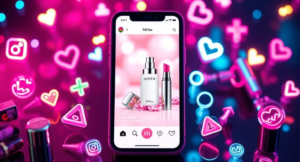Table of Contents

In the competitive beauty industry of today, brands look at every innovative way to increase ROI while maximizing their marketing budget. With the advent of micro-influencers, a powerful solution came into existence that could ensure cost-effective campaigns and high engagement rates. As beauty brands strategize for 2024, micro-influencers are being stifled as key drivers of breakthrough ROIs.
What Are Micro-Influencers and Why They Matter?
Micro-influencers are social media personalities who have between 10,000 and 100,000 followers and are within reach of and more relatable than mega influencers. They design their contents with authenticity around a niche subject that they are sometimes expertly knowledgeable about-skincare, makeup, hair care, or whatnot. While macro-influencers have an enormous following with low interaction, micro-influencers have a very personal relationship with their followers.
For beauty brands, this means more engagement and more trust. Followers perceive micro-influencers as real persons, not celebrities, and that is the reason why their recommendations work better. In the light of this fact, micro-influencers have become a necessity for beauty brands in order to drive efficacy among target audiences and completeness of conversions.
How Micro-Influencers Boost ROI for Beauty Brands
One of the most significant advantages that come with collaborations with micro-influencers is cost-efficiency. Micro-influencers charge significantly lower compared to macro-influencers, which enables the brand to stretch the marketing budget by collaborating with several of them. Simultaneously, smaller-scale influencers drive better engagement rates and are therefore a smart investment for beauty brands seeking higher ROI.
In 2024, the focus is going to shift more towards quality engagement rather than the reach factor itself. They are much better at driving genuine engagement, such as comments, likes, and shares, which lead to conversions. For beauty brands, this often means that with micro-influencers, they can get the best of both worlds: a lower cost per post and stronger audience interaction.
Skincare brands such as The Ordinary and Drunk Elephant have realized the power of micro-influencers in promoting their products. By collaborating with social media influencers who happen to have a genuine interest in skincare, these companies increase their customer reach manifold and drive revenues on a still relatively inexpensive platform.
Micro vs. Macro Influencers in 2024: Which Ones to Choose?
Choosing between micro- and macro-influencers include considerations of budget, reach, and engagement for the beauty brand at hand. While macro-influencers have more than 100,000 followers, they can offer huge visibility but often at higher costs and generally worse engagement rates. On the other hand, although micro-influencers are a lot smaller in scale, they create deeper connections with their audience. In fact, according to a study, microinfluencers drive up to 60% higher engagement rates compared to macro-influencers. This makes them particularly effective for driving product sales, especially in the beauty industry, which requires a lot of trust and authenticity.
In 2024, beauty brands may find that their best mix is leveraging micro-influencers for niche campaigns while macro-influencers build broader brand awareness.
Cost Efficiency and Engagement Rates
The biggest draw for micro-influencers is affordability. With the fee for one macro-influencer collaboration, brands are able to collaborate with several micro-influencers and reach more of their target audience segments. Adding to that, the engagement rate of micro-influencers is very high, generally ranging from 5% to 10%, while for macro-influencers, their engagement falls to about 2% to 3%. That means that even though a macro-influencer may have more followers, micro-influencers generally have more active and engaged communities.
That means for beauty brands, these engagements translate into more concrete results: more website traffic, product sales, and better yields from campaigns in general. Micro-influencers are also peculiarly effective in product launches and targeted campaigns where the level of engagement is important to create buzz.
Real-Life Success Stories
In order to drive home how micro-influencers are able to drive results in beauty marketing, let’s take a closer look at three influencers who have partnered with brands and driven significant engagement and ROI.
Doeneseya is a beauty micro-influencer known for her bold use of color and striking makeup looks. Terribly passionate and loyal following evidences the ability to make impactful content that radically resonates among her audience. Her posts look colorful in fashion and beauty, attracting high engagement; thus, she is one ideal partner for brands that want to launch vibrant attention-catching beauty products.
To beauty brands, the high Doeneseya engagement rate means that her followers are not just ‘blind’ scrolling past her creations; they comment on, like, and even buy some of the products she features. Her genuine love of makeup and artistry helps match brands with credibility and visibility in niche audiences who can become passionate about beauty.
Ashlee, alias @intheglamroom, is a skincare expert and developer of beauty products. She creates very thoughtful content that is well-researched; it always seems like she gives her audience exactly what they need, whether the post is for product reviews or how-to tutorials. With her in-depth posts, full of information, she is a valuable partner in the skincare industry for beauty brands.
Ashlee has been able to forge an organic relationship with her audience while, at the same time, amassing significant experience in the development of beauty products. That inherently means any recommendations she makes are trusted by her audience. Skincare brand collaborations come off organically, which helps businesses reach her rising and active audience without appearing too promotional. Offering innovative skincare solutions, Ashlee is the right micro-influencer to reach such audiences that basically crave an expert in order to guide them in their choice of quality skincare.
With recent great success not only on Instagram but also on YouTube and TikTok, the Canadian influencer @sincerelymissash keeps on being one of the finest examples of how highly engaged and niche micro-influencers drive brand awareness and increase engagement. Her love for all things beauty and skincare really comes alive in the amazing quality of her constant flow-content, spanning from product reviews to tutorials.
How to Leverage Micro-influencers in Beauty Marketing
To get the most out of micro-influencers, here are several best practices to follow when working on a beauty brand:
- Research and Match: identify influencers whose contents and audience align with your brand values. Tools such as Influencer Marketing Hub will help brands find and vet potential influencers.
- Engage Authentically: work with influencers who genuinely love products. Authenticity sells in the beauty space, and consumers are smart enough to spot a forced promotion from a mile away.
- Nurture Long-Term Partnerships: while collaborations may be great as ad-hoc campaigns, it is long-term partnerships that build regard and actually reinforce this three-way relationship among the influencer, the brand, and their audience.
- Track and Optimize: follow the engagement rate, conversions, and follower growth as indications to track the success of your influencer campaigns. Keep improvements coming into strategy based on what really works well.
Micro-Influencers are the Future of Beauty ROI As beauty brands aim to maximize their return in investment this 2024, micro-influencers offer them a better solution. Not only are they cost-effective, but assure high engagement rates and ways to build trust in niche communities. Microinfluencers can play an even bigger role in influencer marketing strategies. Whether you’re launching a new product or just looking for brand awareness, partnering with micro-influencers could be just the thing your beauty brand needs to break through.








